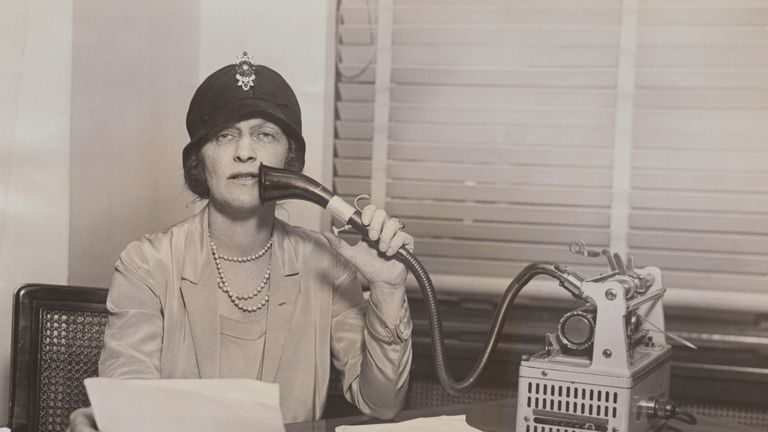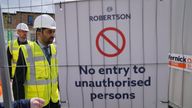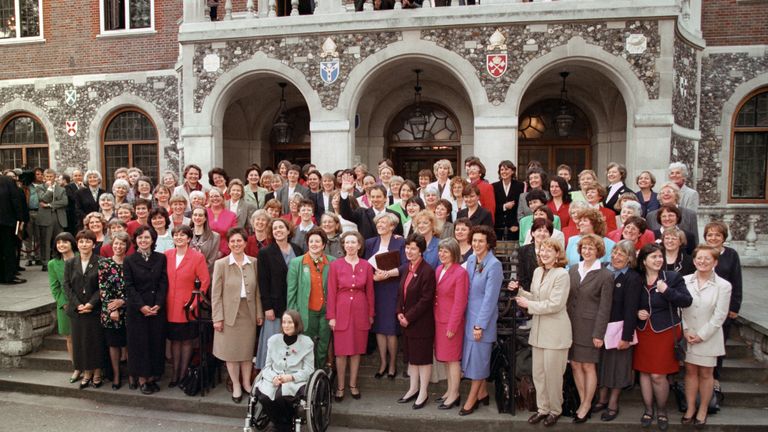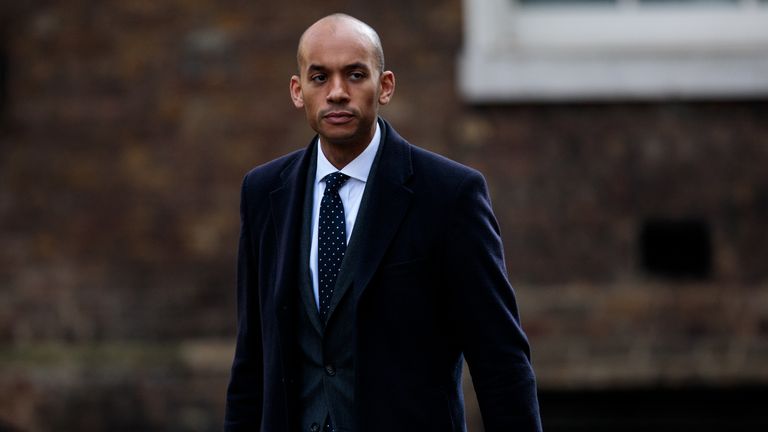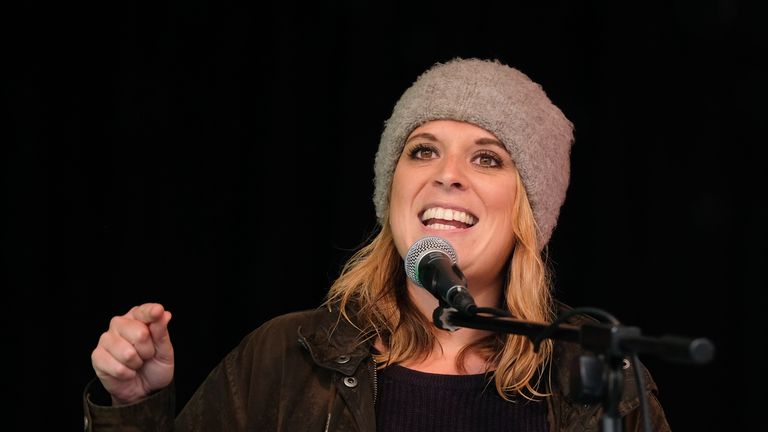Commons people: How diverse are MPs - and do they reflect the UK?
As parliament dissolves for an election, Sky News looks at how the gender, race, age and population of MPs compares with the UK.
Tuesday 12 November 2019 07:15, UK
The House of Commons has become increasingly diverse over the years - but it doesn't yet mirror the country it represents.
Gender
The first woman to be elected to the House of Commons was Constance Markievicz in 1918.
However, she was a member of Sinn Fein - a party which boycotts its seats in parliament - and so she never sat in the Commons.
Conservative Nancy Astor, who won a by-election in December 1919, is regarded by many as the first female representative in parliament.
Since then, there has been a constant female presence in the Commons. The proportion of women jumped in the late 1990s following a Labour initiative under Tony Blair, which led the party's female MPs to be nicknamed "Blair's Babes".
In 1997, the number of female Labour MPs reached 101 - far more than the 37 elected back in 1992. Labour made the most of a landslide to dramatically change the face of parliament.
Among the two main political parties, Labour and the Conservatives, the proportion of female representatives is higher in Labour. In 2017, 45% of Labour MPs were women, compared with 21% in the Conservatives.
That said, the Tories remain the only party to have had female leaders and prime ministers: Margaret Thatcher and Theresa May.
Labour has never had a permanent female leader or a female prime minister and the Liberal Democrats only elected their first female leader, Jo Swinson, in 2019.
There is some work to be done before the number of women in the Commons properly reflects UK society. Nationwide, women make up 51% of the population but just 32% of MPs.
Campaign groups such as 50:50 Parliament are seeking to increase the number of women, from all political parties, standing for roles in all levels of government.
Its founder, Frances Scott, told Sky News: "Rosie Duffield spoke movingly of her experience of coercive control and domestic abuse. Her bravery in bringing this experience to the floor of the Commons was a comfort and inspiration to many women who have suffered. It was the 50:50 Parliament #AskHerToStand campaign that inspired Rosie to stand for election and she went on to win her seat.
"More than 800 women have expressed an interest in standing for elected office right across the political spectrum via the 50:50 Parliament website. Our 'New Girls Network' of peer supporters are helping them take steps to be selected and elected.
"The mother of parliaments needs modernising. At the last election only 12 extra women gained seats in the Commons - at this rate it will take another half-century for women to have equal seats and equal say."
While apolitical campaigns may be fighting for equality in the House, Women2Win founder Anne Jenkin revealed on Twitter that the Conservative Party selection process was not equally split, finding that 15 of 60 selections for seats were women.
BAME
Likewise, BAME representation in the Commons is still lacking. Currently, 8% of MPs are BAME - the highest level since records began - but according to census data, 19.5% of the population comes from an ethnic minority.
There are 52 BAME MPs. If this was to directly reflect the UK population, this number should be closer to 112.
At present, Labour is the party with the highest proportion of black and ethnic minority MPs. In 1987, Labour had four BAME MPs - and the Conservatives' first BAME MP was elected in 1992 under John Major.
For two subsequent elections, Labour were the only party with any BAME representation.
At the 2017 election, Labour had 32 BAME MPs, the Tories had 19, and Liberal Democrats had one. These figures have changed following the defections of Conservative Sam Gyimah and Labour's Chuka Umunna to the Lib Dems.
LGBT
In 2017, there were 45 openly LGBT MPs serving in the Commons. Immediately following the election that year, there was an even split across the Labour and the Conservatives, which had 19 MPs each. Since then, two openly LGBT Conservative MPs have left the party.
Nick Boles quit after he was unable to persuade his colleagues to a compromise on Brexit, and Justine Greening was expelled when she voted against Boris Johnson.
The rate of openly LGBT MPs is about 6%. According to the Office for National Statistics, this is substantially higher than the 2% of the population who describe themselves as lesbian, gay or bisexual (transgender people were not included in the ONS figures).
It is worth noting that the percentage of people who identify as straight decreased to 93.2% in 2017 - 0.6% identified themselves as "other", while 4.1% refused, or did not know how, to identify their sexual orientation.
Statistics on sexuality are not perfect as many people do not wish to be open about their preference, or feel unable to.
Age
The average age of MPs at elections has consistently been about 50 years old.
Conservative MPs elected at general elections over the past 60 years have tended to be younger than their Labour counterparts, while Liberal Democrat MPs are the oldest on average.
Education
Following the 2017 election, eight in 10 MPs were university graduates - and one in four attended the University of Cambridge.
The number of graduate MPs is 17 percentage points higher than in 1951, but the number of Oxbridge graduates has fallen over the same period.
However, there is still a stark difference in the type of education that MPs have had when compared with the rest of society.
Nearly 30% of MPs who entered parliament in 2017 had private schooling, and 24% went to Oxford or Cambridge. But according to The Sutton Trust, only 7% of Britons have had a private education - and less than 1% of the current working population attended Oxford or Cambridge.
In total, 86% of MPs have a university education - and comparatively, just 19% of the working population went to any university.
Occupation
Data from the House of Commons library shows the range of backgrounds that MPs have come from before entering parliament.
Sky News has taken the available information and divided it into six categories. Legal covers those who were barristers, solicitors, or another legal profession. Teacher covers those in education, while business covers those who were company executives, or directors, or worked in some form in private business.
Politicians covers those who were in politics in some way, or who were political organisers. White-collar work covers middle-class professions such as civil service, local government, the armed forces, and those who were in publishing or journalism. Manual workers include traditional blue-collar work like mining.
A rise in the number of MPs who are graduates has come alongside a drop in the number from manual labour backgrounds. There's also been a rise in the number with business and political backgrounds, such as those who moved from local councils into the Palace of Westminster.
Newcomers
While more MPs are moving from political fields into elected representation, there was a drop in the last election in the number of MPs entering the Commons for the first time. Only one in every 10 MPs was a newbie.
On the other hand, at the 1997 and 2010 elections, more than a third of MPs elected were new to the House. The high turnover of MPs on these occasions is attributable to the change of government and to the large numbers of MPs who did not seek re-election.
Disability
Data on diversity in parliament focuses on social backgrounds, and doesn't currently include information about disabilities. The Commons Library says there is no monitoring of disability in parliament.
According to The Guardian, there were five disabled MPs returned to the Commons in the 2017 election. Two Conservatives, two Labour and one Lib Dem made up that total.
It's estimated about 13.3 million people are disabled in the UK, accounting for about 20% of the population.
According to campaign group Disability Politics there are "a handful" of disabled MPs in the UK, but there would need to be 65 in order for parliament to be representative of wider society.

